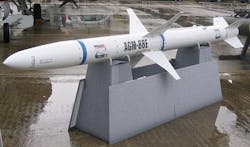Navy orders advanced radar-killing air-to-ground missiles and missile upgrades in $83.4 million deal
PATUXENT RIVER NAS, Md., 24 April 2014. U.S. Navy air warfare experts are ordering another batch of air-to-ground radar-killing missiles and missile upgrades to equip the service's carrier-based fighter-bombers and electronic warfare jets.
Officials of the Naval Air Systems Command at Patuxent River Naval Air Station, Md., announced an $83.4 million contract Wednesday to the Alliant Techsystems Inc. (ATK) Defense Electronic Systems segment in Woodland Hills, Calif., for the AGM-88E Advanced Anti-Radiation Guided Missile (AARGM).
The contract includes the full-rate-production Lot III of AARGM, conversion of 110 AGM-88B High-Speed Anti-Radiation Missiles (HARM) to AGM-88E all-up rounds, and AGM-88E training missiles. AARGM is a supersonic, medium-range, air-launched tactical missile designed to attack and destroy ground-based radar sites and radar-guided ground-to-air-missile batteries.
The newest version of the AGM-88 missile compatible with U.S. and allied strike aircraft, including all variants of the F/A-18, Tornado, EA-18G, F-16, EA-6B, and F-35 (external), ATK officials say. The missile program is a joint venture by the U.S. Department of Defense (DOD) and the Italian Ministry of Defense.
Designed to upgrade the AGM-88 HARM, AARGM features an advanced, digital, anti-radiation homing sensor, millimeter wave radar terminal seeker, global positioning system/Inertial Navigation System (GPS/INS) guidance, net-centric connectivity, and weapon-impact-assessment transmit (WIA).
The AGM-88E provides the U.S. Navy, U.S. Marine Corps and Italian air force with the ability to engage and destroy enemy air defenses and time-critical, mobile targets.
The new missile offers capabilities above and beyond the HARM systems it replaces, including advanced signal processing, and improved frequency coverage, detection range, and field of view; time-critical, standoff strike; missile-impact zone control to prevent collateral damage; counter-emitter shutdown through active millimeter wave radar terminal guidance; and bomb damage assessment.
Related: HARM anti-radar missile moves ahead with planned upgrade to dual-mode seeker
The AARGM features new software and enhanced capabilities to counter radar shutdown and passive radar using an additional active millimeter wave seeker. Previous versions of the missile could be spoofed by turning off radar before the weapon could lock on to their signals. The missile has been in full production since 2012.
A U.S. Marine Corps F/A-18 Hornet squadron will be the first forward-deployed unit with the AGM-88E. The missile initially will be integrated onto the FA-18C/D, FA-18E/F, EA-18G, and Tornado ECR aircraft and later on the F-35. Full operational capability is expected this fall.
On this week's contract, ATK will do the work in Northridge, Calif.; Fusaro, Italy; and Ridgecrest, Calif., and should be finished by late 2016.
For more information contact ATK Defense Electronic Systems online at www.atk.com, or Naval Air Systems Command at www.navair.navy.mil.

